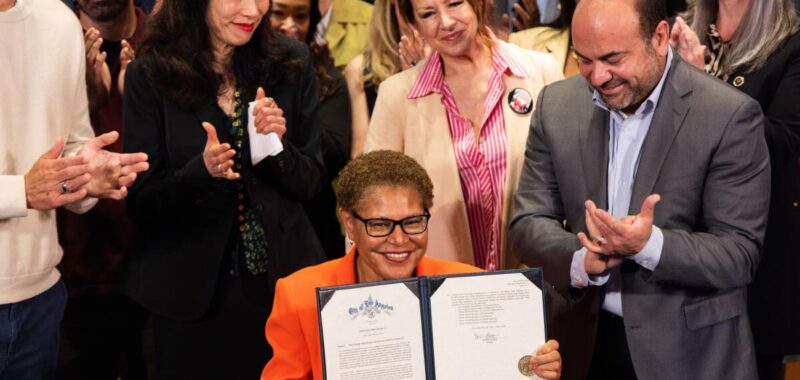
Standing in Hollywood actors guild SAG-AFTRA’s Los Angeles headquarters alongside a cavalcade of film industry players, Mayor Karen Bass pledged Tuesday to make it easier for productions to shoot in Los Angeles.
The mayor signed an executive directive to support local film and TV jobs — an action that she said will lower costs and streamline city processes for on-location filming, as well as increase access to legendary L.A. locations including Griffith Observatory, Central Library and the Port of Los Angeles. The move was cheered by representatives from the Screen Actors Guild-American Federation of Television and Radio Artists and other union leaders.
In the 115-odd years since D.W. Griffith shot the first film in the then-village of Hollywood, L.A. firmly established itself as the global capital of film production.
However, while the city remains internationally synonymous with movie magic, it has hemorrhaged production jobs to other states and countries that offer generous tax incentives, cheaper labor and more filming-friendly bureaucracies.
Now, amid a broader downturn in film and TV production, the local industry finds itself at an existential crossroads.
Will Los Angeles still be a place where middle class, below-the-line entertainment workers can make a living and new productions can pencil out, or has the city permanently ceded that ground?
The changes ordered by the mayor are relatively modest, but industry veterans are hopeful that they will ease some of the burdens faced by productions and smooth logistical issues.
“We’ve taken the industry for granted,” Bass said. “We know that the industry is a part of our DNA here. And sometimes, if you think it’s a part of your DNA, you can think it’s always going to be here.”
Bass, who said her own family had been involved in the film industry for three generations, also urged the state Legislature to pass legislation that would increase film and TV production tax credits to make the state more competitive. When he released his revised budget proposal last week, Gov. Gavin Newsom kept his pledge to double California’s film tax credit to $750 million next year.
Los Angeles’ signature industry has been battered by a series of compounding crises and headwinds in recent years, from the COVID-19 pandemic closures that shuttered then severely curtailed production to the twin Hollywood labor strikes in 2023 and protracted stagnation that followed.
The January 2025 fires were merely the latest blow. An estimated 30 film and television productions were briefly shut down due to the Palisades and Eaton fires, according to industry estimates.
In the first three months of this year, on-location production in the Greater Los Angeles area declined by nearly a quarter, compared with the same period a year earlier.
The pain has reverberated far beyond the studio backlots. Restaurants have struggled to keep their doors open and a stream of Hollywood workers have left the city.
Dwindling filming is having a broader “multiplier effect” on the local economy, said Councilmember Adrin Nazarian, who represents the eastern San Fernando Valley and introduced an earlier City Council proposal to streamline the city’s film permitting process.
“A lot of the folks that are impacted live in the district. So it’s their mortgages. If mortgages aren’t being paid, people are losing homes, if people aren’t spending disposable income at restaurants or on the costs of living — raising their kids, raising their families — those retail tax dollars aren’t coming to the city,” Nazarian said.
The industry’s challenges go far beyond productions not being adequately supported in Los Angeles.
In the post-peak TV era, the film and TV industry has, at least for the time being, significantly contracted.
The recent heyday of the streaming wars, when competing subscription services unleashed a firehose of cash and a glut of content to try and chip away at Netflix’s market dominance, has ended.
Studios are greenlighting fewer shows and shedding jobs. Generous tax incentive programs in other states and abroad have also made it far more difficult for L.A. productions to be economically feasible.
All this means that even if the mayor were to wave a magic wand and make it infinitely easier for productions to shoot on L.A.’s iconic streets, the jobs still wouldn’t automatically follow.
But Bass’ directive will “help the immediate productions that are already here,” said Teamsters Local 399 head Lindsay Dougherty, who represents more than 6,000 movie Teamsters in Hollywood, including drivers and location managers.
“All these things matter,” Dougherty said, while also citing the need for more funding for the state tax credit program and possible federal legislation. “When a production company is looking at budgeting, this is part of it.”
The mayor’s executive directive has a number of components that aim to lower production costs, including reducing the number of city staff required to be on-site at a filming location to a single staff member.
Bass is also directing all city departments to report back on how their current fees “associated with on-site staff or inspections” can be lowered.
The order also aims to make it easier to shoot at a number of particularly illustrious city-owned properties. The city will lower fees for filming at the Griffith Observatory, which film advocates say has become prohibitively expensive to use as a location. Filming will still be limited to times when the observatory is not otherwise open to the public.
Bass also pledged to unsnarl the lengthy insurance review waiting period that has prevented some productions from being able to film at the Port of Los Angeles and said she would reopen downtown’s Central Library to filming.
Industry advocates have been raising these issues with the mayor’s office for the last couple of years and some had previously expressed frustration that Bass had not been more proactive on filming.
Staff writer Samantha Masunaga contributed to this report.

